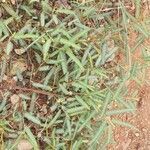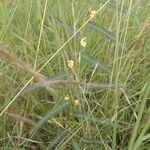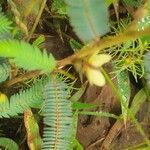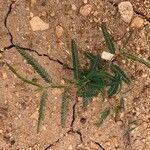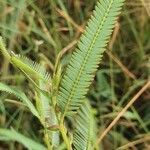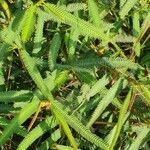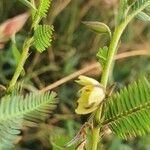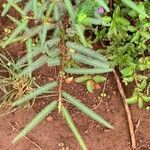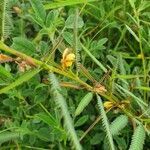Herb with woody base or low shrub up to 1 m, erect or decumbent; branches appres-sed pubescent. Leaves with 20-80 pairs of leaflets, sensitive to touch; stipules linear, acute, 5-10 mm, persistent; petioles 3-10 mm, with a flat, discoid, sessile gland just below the lowest pair of leaflets; rachis serrate or crenate, crested along upper side, not canaliculate, sparsely pubescent, 3-10 cm. Leaflets sessile, linear, very unequal-sided with more or less parallel sides, (2-)4-8 by 1-2 mm (middle ones), glabrous, sparsely ciliate along the margins; apex acute mucronate, base oblique truncate. Flowers supra-axillary, mostly solitary, sometimes 2 or 3 together in a very short raceme; bracts like the stipules; bracteoles similar to the stipules but smaller; pedicels pubescent, 5-10 mm. Sepals lanceolate, 4-8 mm long. Petals bright yellow, obovate to orbicular, equal to or slightly longer than sepals, claw short. Stamens 10-7, filaments 1-2 mm, anthers straight, 2-4 mm, opening by apical pores. Ovary covered with stiff, appressed hairs; style glabrous, recurved; stigma flat, ciliate. Pods flat, strap-shaped, with scattered appressed hairs to nearly glabrous, 3-6 by 0.5 cm. Seeds 10-20, brown, smooth, flat, 4 by 2 mm.
Herbs, suffrutescent, annual or perennial, with woody base, 30-60 cm tall, or low shrubs to 1 m tall, with many slender, puberulent branches. Leaves 4-8 cm, with an orbicular, discoid, sessile gland in upper part of petiole, below lowest pair of leaflets; stipules persistent, linear-subulate, 4-7 mm, with conspicuous longitudinal veins; rachis not canaliculate, sparsely pubescent; leaflets sessile, 20-50(-80) pairs, reddish brown when dry, linear-falcate, 3-4 × ca. 1 mm, midvein near upper margin of blade, very unequally sided, base obliquely truncate, apex acute, mucronate. Flowers supra-axillary, mostly solitary, sometimes 2 or 3 together in a very short raceme; bracts and bracteoles similar to stipules but latter smaller. Sepals lanceolate, 4-8 mm, apex acute. Petals bright yellow, unequal, obovate to orbicular, equal to or slightly longer than sepals, shortly clawed. Stamens 10, alternately 5 shorter and 5 longer; anthers opening by apical pores. Ovary with stiff, appressed hairs; stigma flat. Legume flat, falcate, 2.5-5 × ca. 0.5 cm. Seeds 10-20, flat, smooth. 2n = 16.
A herb or small shrub. It can grow each year from seed or keep growing from year to year. It grows to 1 m high. The stem are wiry and come from a woody rootstock. It is a very variable plant. The leaves are 3-8 cm long and are made up of 20-80 pairs of small leaflets. These are 0.5 cm long by 0.1 cm wide. They are very narrow, thin and crowded. The leaf stalk has a round gland near the top. They have sharp points. They clasp one another along the stalk. They are sensitive to touch. The flowers are about 2 cm across. They occur either on their own or as 2-3 together. They occur in the axils of upper leaves. They are bright yellow. The fruit are straight narrow pods. The pods are 3-4 cm long and 0.5 cm across. They are flattened. There are about 20-25 seeds.
Leaves paripinnate, 7–11(13) × 0.8–1(1.4) cm; stipules 6–11 × 1–2 mm, very narrowly triangular, apex long-acuminate, base rounded, asymmetric, surfaces and margins glabrous; petiolar gland single, dark to pale, 0.3–0.6 × 0.3–0.9 mm, elliptic to circular, sessile to shortly stalked (to 0.3 mm), usually shallowly cup-shaped; rachis crenate-crested; leaflets in (31)40–59 pairs, 3.8–5(8) × 0.7–1.2(1.4) mm, narrowly oblong, asymmetric, base asymmetrically truncate, apex acute to obtuse, shortly mucronate; margins sparsely ascending-ciliate, surfaces glabrous or with at most a few scattered hairs; midrib 0.2 mm from distal margin; 0–2 lateral nerves from base on proximal side of midrib, 2–4 on distal side, often indistinct.
Erect, annual or short-lived perennial to 1.5 m tall; stems with short, crisped hairs. Leaves linear-oblong in outline; stipules acuminate, 4-8 mm long; petiole 1-2 mm long, with sessile, slightly concave gland 0.4 mm diam.; rachis 5-8.5 cm long, crested adaxially; crests crenate or serrulate in profile, sometimes ciliate; leaflets 20-75 pairs, linear, 1.5-5 mm long, 0.5-1 mm wide, glabrous with marginal cilia; midrib excentric. Inflorescences supra-axillary, 1-3-flowered; pedicels 8-15 mm long. Sepals slightly shorter than petals. Petals obovate, 5-7 (-10) mm long. Stamens 10; anthers irregular in size, to c. 3 mm long. Ovary pubescent. Pod 3-5 cm long, 3.5-4.5 mm wide, appressed-pubescent.
Annual, occasionally perennial herb, 0.1-1.6 m high; with erect stem or branching from ground-level to become ± rounded. Leaves: petiolar gland either sessile elliptic, projecting laterally over petiole, yellow becoming red or pink when mature, or sessile circular elliptic, pale yellow margined with a dark central zone. Leaflets sessile in 35-36 pairs, apex asymmetric. Inflorescences 1-3-flowered racemes. Petals pale cream-coloured or yellow to bright yellow, not much exceeding sepals. Pod: valves are ± lanate to villous with scattered hairs. Seeds rhombic, testa shiny brown with lines of darker dots, areole lacking.
Annual or short-lived, perennial herb, up to 0.75 m high. Stems erect, slender, rootstock absent. Leaves with blade linear, 40-80 x 3-12 mm, leaflets in 35-65 pairs, linear, 3-8 x 0.31.3 mm; petiolar gland variable, either sessile or subsessile; rachis crested adaxially. Flowers: inflorescence 1-3-flowered; petals 5-7 mm long, pale cream-coloured or yellow to bright yellow; Jan.-Mar. Pods 35-45 x 3-4 mm.
Annual or short-lived perennial herb, up to 1.6 m high, fibrous-rooted. Leaf rhachis with adaxial surface crested. Petals usually 5.0-7.5 mm long. Flowers pale cream or yellow to bright yellow.
Inflorescences supra-axillary, usually 2–3-flowered; pedicels 0.25–2 cm long in flower, 0.5–2.4 cm in fruit, appressed-pubescent.
Pods 3.7–5.8 × 0.3–0.5 cm, linear, sparsely pubescent with short stiff appressed hairs or with longer more flexuous hairs.
Sepals 5–7.7 × 2–2.8 mm, ovate to narrowly ovate, appressed (or rarely spreading) pubescent outside.
Seeds pale brown, sometimes with small darker spots, 2.2–3 × 1.3–1.8 mm, rounded-rhomboid.
Stems terete, sparsely to densely pubescent with curved appressed hairs.
Ovary densely appressed-pubescent; stigma terminal, fringed with hairs.
Annual erect or decumbent herb, sometimes woody at the base.
Petals yellow, broadly obovate, 4.5–9.5 × 3–7 mm.
Stamens 9–10, four larger than the rest.
